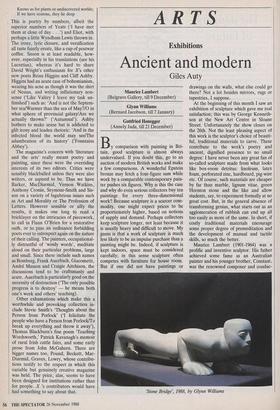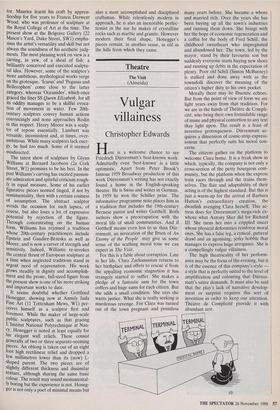ARTS
Exhibitions
Ancient and modern
Giles Auty
Maurice Lambert (Belgrave Gallery, till 9 December) Glynn Williams (Bernard Jacobson, till 7 January)
By comparison with painting in Bri- tain, good sculpture is almost always undervalued. If you doubt this, go to an auction of modern British works and make a few comparisons. A wonderful Epstein bronze may fetch a four-figure sum while work by a comparable contemporary pain- ter pushes six figures. Why is this the case and why do even serious collectors buy ten paintings for every three-dimensional work? Because sculpture is a scarcer com- modity, one might expect prices to be proportionately higher, based on notions of supply and demand. Perhaps collectors keep sculpture longer, not least because it is usually heavy and difficult to move. My guess is that a work of sculpture is much less likely to be an impulse purchase than a painting might be. Indeed, if sculpture is kept indoors, space must be considered carefully; in this sense sculpture often competes with furniture fox house room. But if one did not have paintings or drawings on the walls, what else could go there? Not a lot besides mirrors, rugs or tapestries, I suppose.
At the beginning of this month I saw an exhibition of sculpture which gave me real satisfaction; this was by George Kenneth- son at the New Art Centre in Sloane Street. Unfortunately the show closes on the 26th. Not the least pleasing aspect of this work is the sculptor's choice of beauti- ful, traditional materials to carve. These contribute to the work's poetry and ancient, dignified presence to no small degree: I have never been any great fan of so-called sculpture made from what looks like box-room detritus: linoleum, latex foam, perforated zinc, hardboard, pig-wire etc. Of course, such materials are cheaper by far than marble, lignum vitae, green Hornton stone and the like and allow students, say, to experiment formally at no great cost. But, in the general absence of transforming genius, what starts out as an agglomeration of rubbish can end up all too easily as more of the same. In short, if costly traditional materials encourage some proper degree of premeditation and the development of manual and tactile skills, so much the better.
Maurice Lambert (1901-1964) was a prolific and inventive sculptor. His father achieved some fame as an Australian painter and his younger brother, Constant, was the renowned composer and conduc- 'Stone Bridge', 1988, by Glynn Williams tor. Maurice learnt his craft by appren- ticeship for five years to Francis Derwent Wood, who was professor of sculpture at the Royal College of Art at the time. The present show at the Belgrave Gallery (22 Mason's Yard, Duke Street, SW1) empha- sises the artist's versatility and skill but not always the soundness of his aesthetic judg- ments. The most pleasing work on view is a carving, in yew, of a shoal of fish: a brilliantly conceived and executed sculptu- ral idea. However, some of the sculptor's more ambitious, mythological works verge on the grotesque. 'Icarus' and 'Pegasus and Bellerophon' come close to the latter category, whereas `Oceanides', which once graced the liner SS Queen Elizabeth, for all its oddity manages to be a skilful evoca- tion of movement in water. Few 20th- century sculptors convey human actions convincingly and none approaches Rodin in this respect. Henry Moore was a sculp- tor of repose essentially. Lambert was versatile, inconsistent and, at times, over- ambitious. While many sculptors lack ener- gy, he had too much. Some of it seemed misdirected.
The latest show of sculpture by Glynn Williams at Bernard Jacobson (2a Cork Street, W1) promises to be his best. In the past Williams's carving has excited passion- ate admiration and spiteful criticism rough- ly in equal measure. Some of his earlier figurative pieces seemed tinged, if not by sentimentality, then with a certain cosiness of assumption. The abstract sculptor avoids the occasion for such lapses, of course, but also loses a lot of expressive Potential by rejection of the figure. Through concentrating on the human form, Williams has rejoined a tradition whose 20th-century practitioners include Epstein and Gaudier-Brzeska as well as Moore, and is now a carver of strength and sensitivity. Indeed, Williams re-invokes the central thrust of European sculpture at a time when neglected traditions stand in urgent need of rejuvenation. His work grows steadily in dignity and accomplish- ment and the prone, full-sized figure from the present show is one of his more striking and important works to date.
It seems doubtful whether Gottfried Honegger, showing now at Annely Juda Fine Art (11 Tottenham Mews, W1) per- ceives himself as a sculptor first and foremost. While the maker of large-scale public sculptures, such as that gracing L'Institut National Polytechnique at Nan- cy, Honegger is noted at least equally for his elegant wall reliefs. These consist generally of two or three separate-seeming pieces. An oblong is taken out of an eight foot high rectilinear relief and dropped a few millimetres lower than its (now) L- shaped parent. The two pieces are of slightly different thickness and dissimilar texture, although sharing the same basic Colour. The result may sound monumental- ly boring but the experience is not. Honeg- ger is not only a poet of minimal means but also a most accomplished and disciplined craftsman. While relentlessly modern in approach, he is also an inexorable perfec- tionist in the use he makes of crystalline rocks such as marble and granite. However modern their final shape, Honegger's pieces remain, in another sense, as old as the hills from which they came.











































































 Previous page
Previous page